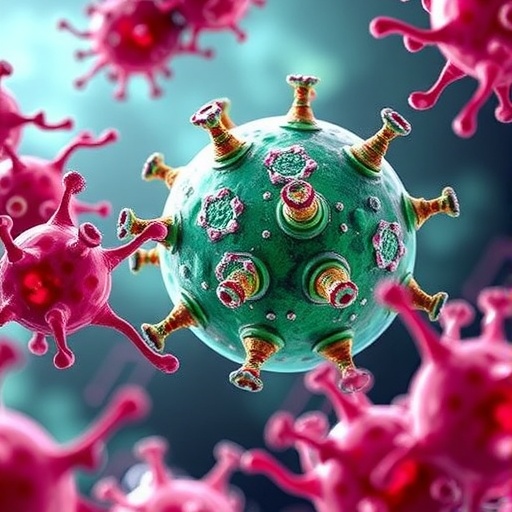In a groundbreaking study set to redefine our understanding of bacterial signaling and antibiotic resistance, researchers from the Institute of Science Tokyo have unraveled an intricate molecular mechanism that enables bacteria to sense and respond to hydrogen sulfide (H₂S) through a heme-dependent process. This discovery illuminates a previously hidden role of heme, beyond its classical functions, in modulating bacterial gene expression and stress resilience, a finding that could revolutionize future antibiotic development strategies.
Bacteria inhabit dynamic and often hostile environments, necessitating sophisticated systems to detect and adapt to fluctuating chemical signals. Among these, hydrogen sulfide, a small gaseous molecule containing sulfur, acts as a pivotal signaling entity influencing bacterial metabolism and survival pathways. Although H₂S is recognized for its capacity to regulate bacterial defense mechanisms, the exact biochemical underpinnings through which bacteria perceive and exploit this gas have remained elusive—until now.
Led by Professor Shinji Masuda and graduate student Ryoma Iwata, the investigative team embarked on an incisive exploration into the molecular dialogue between bacterial transcription factors and hydrogen sulfide. Their research focuses on two key proteins—SqrR from Rhodobacter capsulatus and YgaV from Escherichia coli—that orchestrate gene regulation in response to H₂S exposure. By leveraging a suite of biochemical assays alongside advanced structural and functional analyses, the team dissected how these transcription factors interact with H₂S in the context of heme cofactor presence and oxygen availability.
Central to their findings is the revelation that heme bound to the transcription factors acts as a catalytic agent facilitating the transformation of H₂S into polysulfides, reactive sulfur species characterized by multiple sulfur atoms bonded in chains. This conversion is crucial as polysulfides engage directly with cysteine residues on the transcription factors, forging tetra-sulfide (S–S–S–S) bridges that induce conformational changes. Such structural modulation impairs the transcription factors’ DNA-binding affinity, thereby triggering a regulatory cascade that upregulates genes linked to sulfide metabolism, anaerobic respiration, and oxidative stress defense.
Professor Masuda emphasizes the dual functionality of heme in this signaling axis: “Heme is not merely a passive sensor for hydrogen sulfide; it actively drives a vital chemical conversion that modulates the bacterial genetic program.” This insight uncovers a nuanced mechanism where the chemical reactivity of heme facilitates precise protein modifications, ultimately directing gene expression patterns pivotal for bacterial adaptation and survival.
Intriguingly, oxygen availability emerges as a critical determinant in this signaling pathway. In aerobic conditions, heme enables the oxidation of H₂S to polysulfides, fostering transcription factor modification and subsequent gene activation. Conversely, in oxygen-limited environments, heme binding inhibits the oxidation reaction, preventing polysulfide formation and thus silencing the sulfide-derived signals. This oxygen-dependent toggle ensures that bacteria tailor their responses to the prevailing environmental conditions, balancing metabolic needs and stress responses efficiently.
The functional implications of this mechanism extend profoundly into the realm of antibiotic resistance. By modulating gene expression through H₂S sensing, bacteria can strengthen defenses against oxidative damage and antibiotic assault, enhancing their survival odds. The study posits that disrupting the heme-mediated redox chemistry that enables this transcriptional regulation could cripple bacterial resilience mechanisms, offering a fresh and highly specific target for developing next-generation antimicrobials.
Beyond its immediate biomedical relevance, this discovery reshapes the broader scientific understanding of heme biology. Traditionally lauded for its roles in oxygen transport and cellular respiration, heme now reveals itself as a nuanced catalyst for post-translational modifications that fine-tune gene regulatory networks. This newfound dimension underscores the versatility of heme and invites further exploration into similar redox-dependent signaling systems across diverse organisms.
Looking ahead, the research team plans to investigate whether analogous heme-centric pathways operate within other bacterial species or respond to distinct environmental signaling molecules. Such exploration could unearth novel cellular communication systems pivotal to microbial ecology and pathogenesis, shedding light on fundamental principles of life at the molecular level.
The profound consequences of this work resonate with pressing global public health challenges. Antibiotic resistance represents an escalating threat, undermining the efficacy of existing treatments and demanding innovative solutions. Targeting the heme-driven H₂S sensing pathway exemplifies a strategic avenue that circumvents conventional resistance mechanisms, potentially revitalizing the antimicrobial arsenal.
This landmark study, published in the October 2025 issue of Redox Biology, epitomizes the power of interdisciplinary research in elucidating complex biological phenomena. Through meticulous biochemical interrogation and structural elucidation, it paints a detailed picture of bacterial adaptation, offering tangible hope for combating recalcitrant infections that imperil human health worldwide.
As we deepen our grasp of microbial signaling intricacies, the boundaries between fundamental biology and therapeutic innovation continue to blur. The revelations from Masuda’s team not only enrich the scientific narrative around microbial resilience but also sculpt a pathway toward transformative treatments that harness molecular precision to outmaneuver bacterial defences.
In summary, this pioneering research unpacks a sophisticated heme-dependent mechanism whereby bacteria detect and convert hydrogen sulfide into reactive polysulfides, driving transcription factor modifications that regulate gene expression and fortify stress tolerance. Oxygen concentration intricately modulates this pathway, balancing gene activation with environmental cues. The work holds promising potential to inspire novel antibiotic development, addressing one of the most formidable healthcare challenges of the 21st century.
Subject of Research: Not applicable
Article Title: Heme bound to the bacterial transcription factor SqrR/YgaV catalyzes oxygen-dependent conversion of hydrogen sulfide to polysulfide for regulated gene expression
News Publication Date: 31-Jul-2025
Web References: https://doi.org/10.1016/j.redox.2025.103801
References: Not provided
Image Credits: Institute of Science Tokyo
Keywords: Microbiology, Antibiotics, Drug resistance, Bacteria, Biochemistry, Signal transduction, Gene regulation, Infectious diseases, Molecular biology, Proteins




